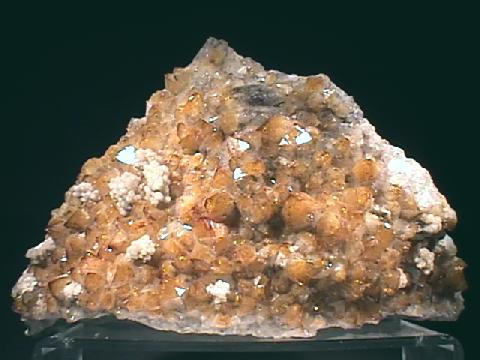
CITRINE
Specimen cit-11
$ 180.00
Dims: 12.5 x 7.6 x 4.4" (31.8 x 19.3 x 11.2 cm)
Wt: 13.7 lbs. (6.2 kg)
Minas Gerais, Brazil
This museum-sized piece consists of a large chunk of igneous rock that is partly coated with a druse of Citrine crystals. These crystals generally do not exceed 1.0" (2.5 cm) in either length or diameter. They are generally in very good condition- there is only one area of considerable damage- and all have excellent hexagonal prismatic form. Their yellow color concentrates to an almost brownish-orange at their tips, making me think that the piece was heat-treated, and their clean faces have a vitreous luster. All are transparent but clouded by many internal fractures, and some contain tiny, dark inclusions. A few sprays of dull white calcite rest atop the druse.
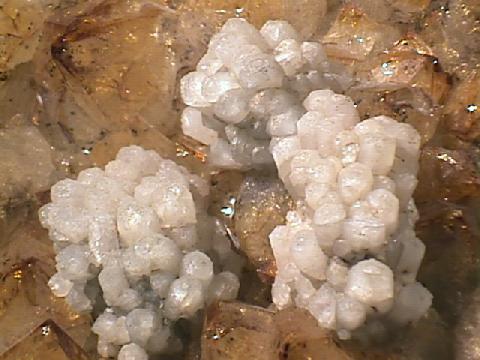
 Amethyst Galleries' Mineral Gallery MINERALS |
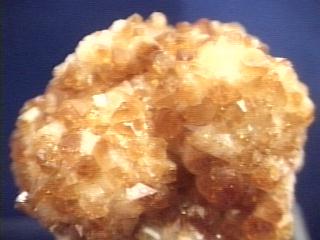
CITRINE specimen cit-1
$ 30.00
$ 30.00
Dims: 3" x 2-7/8" x 2-1/2"
Wt: 12.8 oz
Minas Gerais, Brazil
This excellent little piece of Citrine is well-coated with crystals, some reaching 1/4 inch long and 3/8 inch in diameter. They are an orange-yellow color, indicating artificial heat-treatment, and the piece rests on a base that is part crystalline and part microcrystalline, with many small "vugs." Most of these hollows are at least partially filled with a rusty substance that could be gouged out with a dental pick, leaving a network of "gopher tunnels." (Yet another unintended play on words- somebody sedate me!) This is a gorgeous, paperweight-sized specimen that is waiting for a loving home.

cit-1 ($ 30.00)
Minas Gerais, Brazil
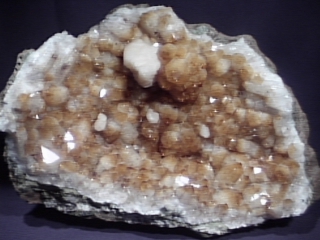
$ 150.00
Dims: 10.5" x 7.0" x 3.8" (26.7 x 17.8 x 9.7 cm)
Wt: 9.2 lbs. (4.1 kg)
Minas Gerais, Brazil
One of the larger Citrine specimens that we have available, this specimen consists of a portion of a geode whose insides were once covered with a druse of large amethyst crystals. We believe that this particular geode was then exposed to volcanic heat while still encased in the rock, wherein it was turned an appealing yellow-gold coloration. Many such specimens, however, are harvested as amethyst and then heat-treated, allowing the included destabilized iron atoms to stabilize, turning more of a rusty-brown color. Because the druse lines a convex surface, the crystals are well-protected and show no damage besides that of some crystals on the druse's edges. All occur in the hexagonal prismatic form, and prism faces are actually visible, as some of the crystals formed parallel to the surface. All have a vitreous luster and transparence at their terminations, which clouds towards their bases. The tip of each termination is very clear, but shows internal fractures less than 0.3" (8 mm) below the tip, which gain in concentration towards the base. A few badly-formed but still definable calcite crystals have grown on the Citrines, and are white and translucent, with a dull luster. The specimen stands upright, and some round felt pads have been put on the outer surface of it to help prevent scratching. It is a very impressive specimen- we have some difficulty in finding larger pieces like these for reasonable prices.
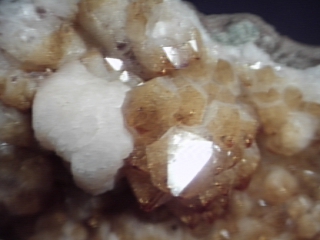

Minas Gerais, Brazil
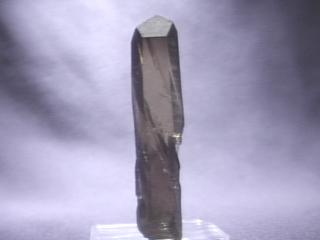
CITRINE specimen cit-3
$ 50.00
$ 50.00
Dims: 3.3" x 0.7" x 0.7" (8.4 x 1.8 x 1.8 cm)
Wt: 1.24 oz. (35.4 g)
Gelannoe, Ural Mountains, Russia
This rather simple hand specimen consists of a single long, slender, hexagonal prismatic Citrine crystal. It is unusual in the fact that most Citrine occurs as a druse of stubby crystals that line the interior of a geode, and usually consist of no more than a hexagonal pyramidal termination. The crystal is in excellent condition, showing almost no human-induced damage, and has very good form, with well-defined edges and flat faces that show a vitreous luster. All of the termination faces, however, show more of a pearly luster due to a pale brown, opaque impurity that is embedded in them. The crystal is transparent and shows excellent clarity, with few internal flaws, and has a rather odd yellow coloration that has a very subtle hint of green to it. It is also rather unusual that this crystal shows noticeable phantom lines of smoky color near its termination. It is a really strange but beautiful specimen.
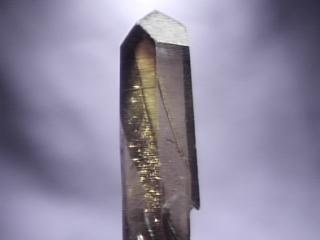

cit-3 ($ 50.00)
Gelannoe, Ural Mountains, Russia
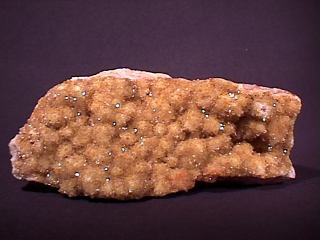
CITRINE specimen cit-4
$ 50.00
$ 50.00
Dims: 6.3" x 3.0" x 2.4" (16.0 x 7.6 x 6.1 cm)
Wt: 1 lb., 8.4 oz. (692 g)
Minas Gerais, Brazil
This is what comes to my mind when I think about Citrine specimens. This piece consists of a druse of tiny, yellow-orange crystals that was once part of a geode. There are only three visible area of damage on the druse and they are quite obvious, showing the whitish color of crushed crystals. The crystals are extremely small, not exceeding 2 mm in length. They have the standard hexagonal prismatic form, though their terminations appear to be trigonal, lacking the "secondary" faces. All appear to be transparent and reasonably clear. They seem to be bunched in rounded clusters that give the surface an almost botryoidal texture. This is due to the fact that the druse covers a druse of much larger crystals.
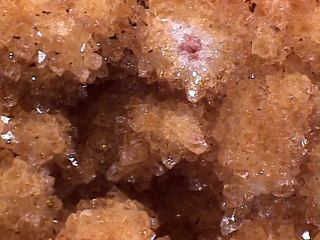

cit-4 ($ 50.00)
Minas Gerais, Brazil
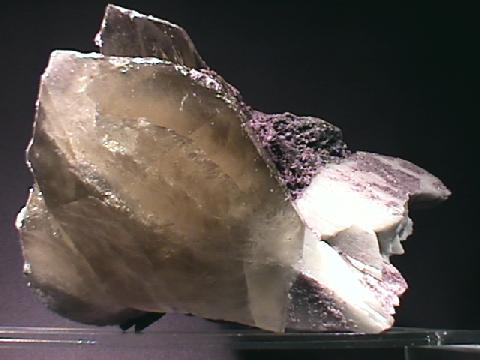
$1200.00
Dims: 8.7 x 6.0 x 5.3" (22.1 x 15.2 x 13.5 cm)
Wt: 7.9 lbs. (3.6 kg)
Minas Gerais, Brazil
This specimen consists primarily of two large, partly intergrown Citrine crystals. These crystals are the largest Citrines that we have yet had in stock- the larger has dimensions of 5.9 x 4.8 x 3.4" (15.0 x 12.2 x 8.6 cm), and the smaller measures 3.5 x 1.8 x 1.6" (8.9 x 4.6 x 4.1 cm). Both are in good condition, though the larger crystal shows considerable damage about its termination- this includes a large crack that runs through part of the crystal, wherein a noticeable chunk of material is missing around it. The crystals both have excellent hexagonal prismatic form, with well-defined edges and clean faces that possess the standard vitreous luster. Its color is a pale brown-yellow and though large portions of each crystal are transparent, they contain many internal fractures and cloudy and veil-like inclusions. They rest on a base that is made up of portions of at least one large albite crystal, several partial schorl crystals, a few muscovite "books", and thousands of tiny lepidolite books that are intergrown to form bizarre formations that are too string-like to be botryoidal.
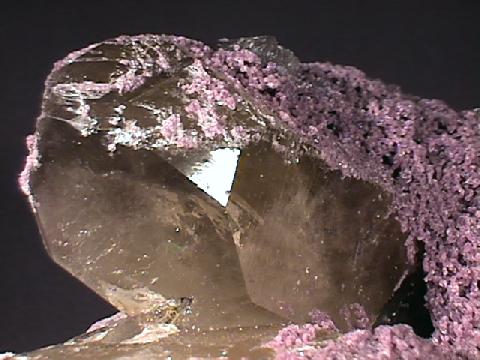

Minas Gerais, Brazil
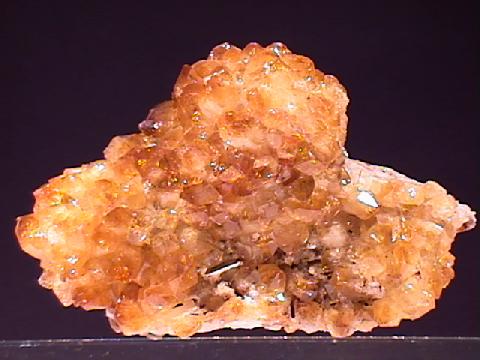
CITRINE specimen cit-6
$ 25.00
$ 25.00
Dims: 3.7 x 2.8 x 1.8" (9.4 x 7.1 x 4.6 cm)
Wt: 6.37 oz. (180.7 g)
Minas Gerais, Brazil
A somewhat nodular druse of small Citrine crystals makes up the bulk of this small hand specimen. These crystals are generally in very good condition, as they tend to show only very minor damage on their most exposed edges. They do not exceed 0.3" (8 mm) along any dimension, and show excellent hexagonal prismatic form, though their prism faces are mostly obscured due to their tight intergrowth. All have well-defined edges and clean faces that possess the standard vitreous luster. Their color is a pale yellow with hints of orange-brown, and this color fades as their size decreases. All are at least dimly transparent, as they contain a substantial number of inclusions and internal fractures. All rest on a base that appears to be made up of agate epimorphs after calcite, as there are several "molds" of thin, flat calcite blades that are visible in the agate.

cit-6 ($ 25.00)
Minas Gerais, Brazil
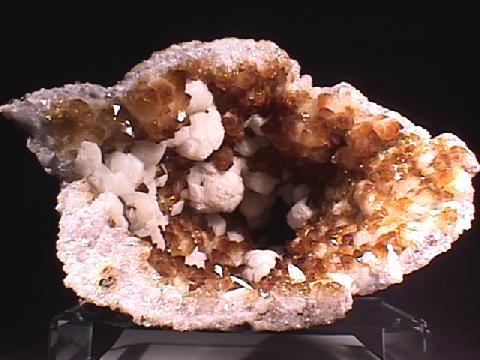
CITRINE specimen cit-7
$ 225.00
$ 225.00
Dims: 11.0 x 11.0 x 7.6" (27.9 x 27.9 x 19.3 cm)
Wt: 12.1 lbs. (5.5 kg)
Minas Gerais, Brazil
This specimen consists of a conical section of a geode which is made up almost entirely of Citrine. The crystals are in the form of a druse that once lined the inside of an air bubble in lava. They originated as amethyst, but heat-treatment turned them a deep orange-yellow coloration and caused most of the lava skin to flake off. Being sheltered inside a depression, almost all of the crystals are undamaged and in pristine condition. The largest achieve lengths of nearly 2" (5 cm) and diameters of 1" (2.5 cm). All have excellent hexagonal prismatic form, though their prism faces and edges are mostly obscured or destroyed by intergrowth. Their edges are very well-defined, and their faces are clean, smooth, and possess the standard vitreous luster. They are transparent, though most of their clarity is hampered by severe internal fracturing. Among the Citrines are many white calcites- some of these have a nearly "nail head" form, though all are intergrown into clusters and rather warped. They have a dull waxy luster and are translucent at best.
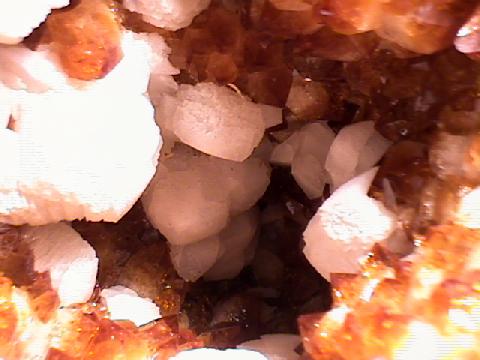

cit-7 ($225.00)
Minas Gerais, Brazil
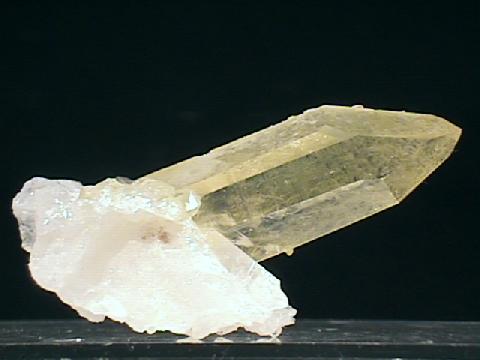
CITRINE specimen cit-8
$ 48.00
$ 48.00
Dims: 2.6 x 1.4 x 1.2" (6.6 x 3.6 x 3.0 cm)
Wt: 1.50 oz. (42.7 g)
Montgomery County, Arkansas, U.S.A.
A cluster of Citrine crystals comprises this specimen. Most of the associated crystals are damaged, but the largest is intact and in excellent condition. It has dimensions of 2.5 x 0.7 x 0.6" (6.4 x 1.8 x 1.5 cm) and shows excellent hexagonal form, with well-defined edges and generally clean faces- 2 prism faces, however, are studded with smaller, partly-intergrown crystals. It has a very odd pale yellow coloration that I first attributed to a rust coating. However, it turns out that this iron oxide layer rests a few molecular widths beneath the surface, and so cannot be removed with acid! I thought of labeling the specimen as a quartz, but decided against it due to the fact that its yellow color is caused from iron oxide inclusions, as it is supposed to be with Citrine. The crystal is transparent and very clear, though it does contain some cloudy inclusions and a few internal fractures near its base.

cit-8 ($ 48.00)
Montgomery County, Arkansas, U.S.A.
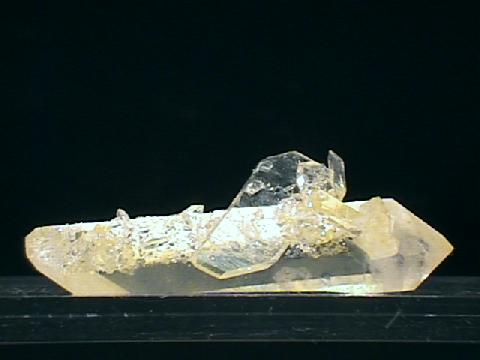
CITRINE specimen cit-9
$ 45.00
$ 45.00
Dims: 2.2 x 0.8 x 0.7" (5.6 x 2.0 x 1.8 cm)
Wt: 16.3 g
Montgomery County, Arkansas, U.S.A.
This small Quartz cluster consists basically of 6 intergrown "float" crystals- I see no place where they were attached to a base or host rock. The largest of these crystals has dimensions of 2.3 x 0.6 x 0.5" (5.8 x 1.5 x 1.3 cm) and acts as a base for the smaller crystals. All of these are in excellent condition, showing almost no visible damage, and all have excellent hexagonal form, with well-defined edges and clean faces. The second-largest crystal is flattened so as to be essentially tabular. They have a slightly dull vitreous luster and are transparent and moderately to very clear. Their color is very unusual for this locality- all have a yellow coloration with a slight hint of orange. This coloration is caused by a very thin layer of iron oxide which is trapped a few microns below each exposed surface. There is no host rock of any sort present.

cit-9 ($ 45.00)
Montgomery County, Arkansas, U.S.A.
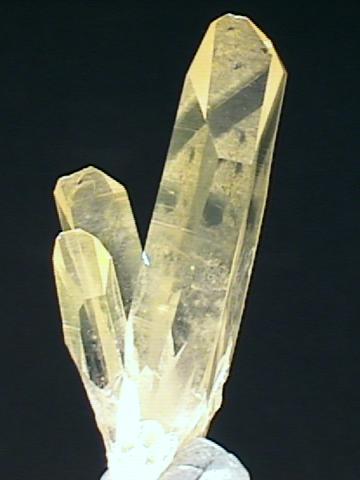
CITRINE specimen cit-10
$ 32.00
$ 32.00
Dims: 2.8 x 1.2 x 1.1" (7.1 x 3.0 x 2.8 cm)
Wt: 1.35 oz. (38.4 g)
Montgomery County, Arkansas, U.S.A.
This Quartz cluster is in very good condition- 2 crystals show small areas of visible damage, but this damage is old and slightly healed over. The largest crystal in the cluster has dimensions of 2.8 x 0.7 x 0.6" (7.1 x 1.8 x 1.5 cm) and like the others, has excellent hexagonal prismatic form, with well-defined edges and clean faces that possess a somewhat dull vitreous luster. All are transparent and quite clear, containing only a few cloudy inclusions. All have a rather bright yellow coloration with a noticeable orange tinge that is caused by a layer of iron oxide which is trapped just beneath the surface of each crystal. There is no host rock present.

cit-10 ($ 32.00)
Montgomery County, Arkansas, U.S.A.

CITRINE specimen cit-11
$ 180.00
$ 180.00
Dims: 12.5 x 7.6 x 4.4" (31.8 x 19.3 x 11.2 cm)
Wt: 13.7 lbs. (6.2 kg)
Minas Gerais, Brazil
This museum-sized piece consists of a large chunk of igneous rock that is partly coated with a druse of Citrine crystals. These crystals generally do not exceed 1.0" (2.5 cm) in either length or diameter. They are generally in very good condition- there is only one area of considerable damage- and all have excellent hexagonal prismatic form. Their yellow color concentrates to an almost brownish-orange at their tips, making me think that the piece was heat-treated, and their clean faces have a vitreous luster. All are transparent but clouded by many internal fractures, and some contain tiny, dark inclusions. A few sprays of dull white calcite rest atop the druse.


cit-11 ($180.00)
Minas Gerais, Brazil
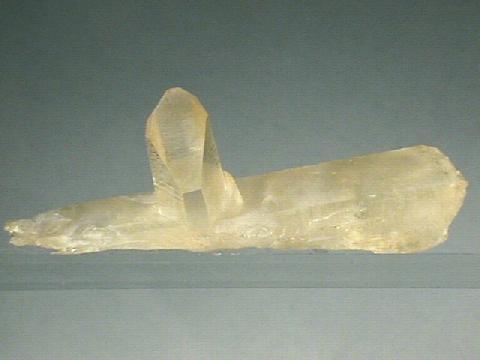
CITRINE specimen cit-12
$ 27.00
$ 27.00
Dims: 3.2 x 1.2 x 1.1" (8.1 x 3.0 x 2.8 cm)
Wt: 1.28 oz. (36.3 g)
Montgomery County, Arkansas, U.S.A.
This hand specimen consists of two intersecting Citrine crystals. One of these is broken and mostly incomplete, but the breakage has healed over- it measures 3.2 x 1.1 x 0.5" (8.2 x 2.8 x 1.2 cm). The smaller crystal measures 1.0 x 0.5 x 0.5" (2.5 x 1.3 x 1.2 cm) and has excellent hexagonal form. Both have a pale orange-yellow coloration and the standard vitreous luster. The small crystal is transparent and quite clear, whereas the larger one is mostly cloudy due to inclusions and internal fractures. There is no host rock present, and the piece is a "floater", showing no place where it was attached to a base.

cit-12 ($ 27.00)
Montgomery County, Arkansas, U.S.A.
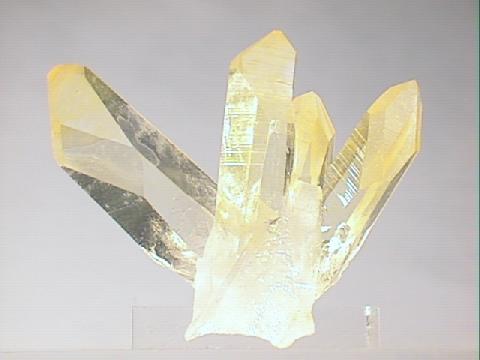
CITRINE specimen cit-13
$ 60.00
$ 60.00
Dims: 1.9 x 1.6 x 0.7" (4.8 x 4.1 x 1.8 cm)
Wt: 22.0 g
Montgomery County, Arkansas, U.S.A.
Four intersecting Citrine crystals make up this specimen. All are in excellent condition and have excellent hexagonal form. Their pale yellow coloration has a very faint hint of orange, and is caused by a very thin layer of iron oxide that is trapped just a few molecular widths beneath the surface of each crystal. All are transparent and quite clear, and their collective base is partly-healed. There is no host rock present.

cit-13 ($ 60.00)
Montgomery County, Arkansas, U.S.A.
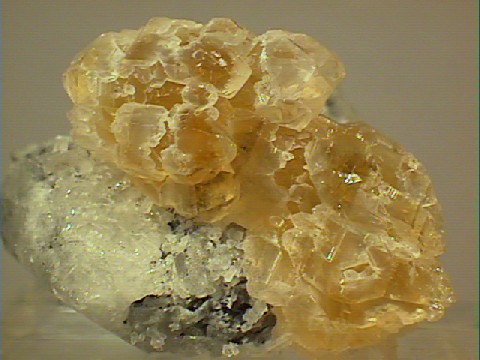
CITRINE specimen cit-14
$ 25.00
$ 25.00
Dims:1.3x1.3x1.0" (3.3x3.3x2.5 cm)
Wt: 0.7oz. (20g)
San Bartolo Mine, Charcas, San Luis Potosi, Mexico
Two intergrown clusters of citrine crystals rest on a matrix of impure danburite in this specimen. The citrines have adopted an almost elestial crystal habit. The terminations on these crystals are white, while the remainder of the crystals are a pale golden color. This gives the effect of a frosted look to these citrines. Upon examination with a loupe, one can see that many of these citrines are in fact double terminated. The tips of two of these crystals show some damage, however, this is minor.

cit-14 ($ 25.00)
San Bartolo Mine, Charcas, San Luis Potosi, Mexico
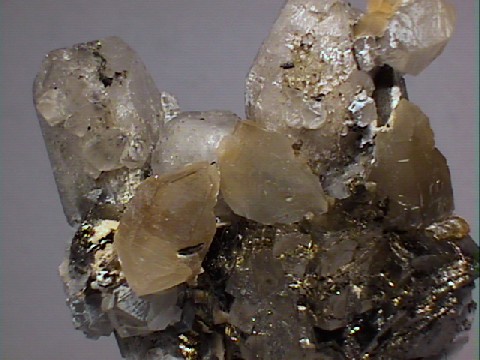
CITRINE specimen cit-15
$ 54.00
$ 54.00
Dims:2.2x1.9x1.5" (5.6x4.8x3.8 cm)
Wt: 3.2oz. (91g)
San Bartolo Mine, Charcas, San Luis Potosi, Mexico
This is a combination specimen. Four large (to 1.4", 3.6cm) crystals of danburite share a bit of matrix with pyrite crystals and quartz crystals. Three of the five quartz crystals show a distinctive yellow citrine color, while the remainder are more of a milky hue. One citrine and one of the milky quartz crystals are double terminated. Several small quartz crystals are scattered over the danburite crystals, but these do not show the citrine color. There is only minor damage to this specimen.
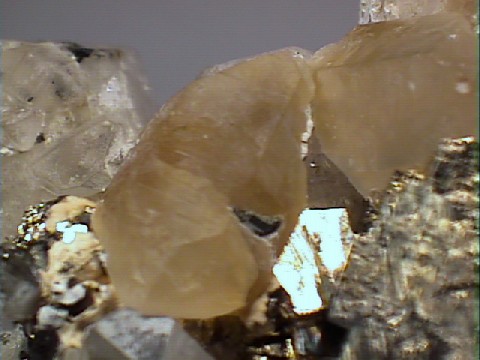

cit-15 ($ 54.00)
San Bartolo Mine, Charcas, San Luis Potosi, Mexico
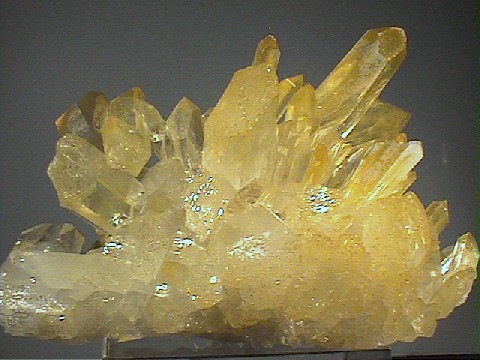
CITRINE specimen cit-16
$ 185.00
$ 185.00
Dims: 3.7x2.7x2.4" (9.5x6.8x6.2 cm)
Wt: 7.35 oz (208 g)
Collier Creek Mine, Montgomery County, Arkansas, USA
This variety of citrine (the yellow variety of quartz) is generated by a surface coloration. The crystals are essentially a clear prismatic quartz with only a thin layer of yellow at the surface. It appears to be a coating on the quartz, but it is actually a layer of iron oxide trapped in the outermost layer of quartz. It is unusual for citrine to have elongated prismatic crystals such as these, except when formed in this manner.
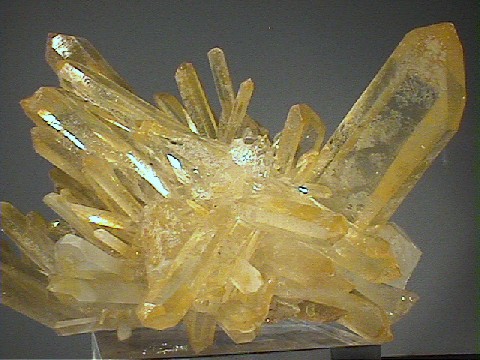

cit-16 ($185.00)
Collier Creek Mine, Montgomery County, Arkansas, USA
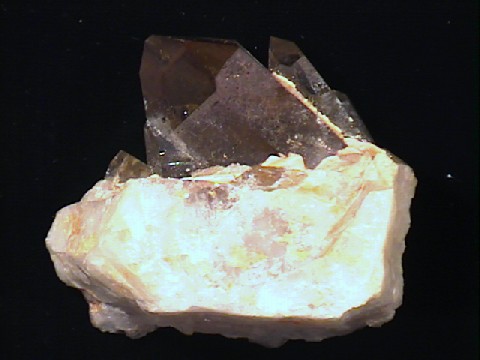
CITRINE specimen cit-17
$ 63.00
$ 63.00
Dims: 2.0x1.2x1.6" (5.0x3.1x4.1cm)
Wt: 2.63 oz. (74.3g)
Murzinka, Ural Mountains, Russia
From a white quartz base emerge a cluster of crystals which are milky white at their bases but which are a transparent brownish-yellow for the bulk of their length. These citrine crystals are well formed and undamaged, although the sides of the prismatic crystals are lightly frosted (small pits, under a loupe) so that only the terminations reveal the internal clarity of the crystals.
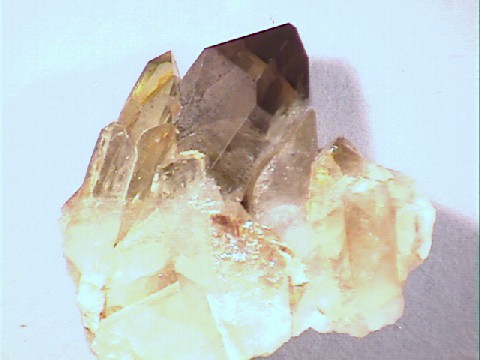

cit-17 ($ 63.00)
Murzinka, Ural Mountains, Russia

CITRINE specimen cit-17
$ 63.00
$ 63.00
Dims: 2.0x1.2x1.6" (5.0x3.1x4.1cm)
Wt: 2.63 oz. (74.3g)
Murzinka, Ural Mountains, Russia
From a white quartz base emerge a cluster of crystals which are milky white at their bases but which are a transparent brownish-yellow for the bulk of their length. These citrine crystals are well formed and undamaged, although the sides of the prismatic crystals are lightly frosted (small pits, under a loupe) so that only the terminations reveal the internal clarity of the crystals.


cit-17 ($ 63.00)
Murzinka, Ural Mountains, Russia
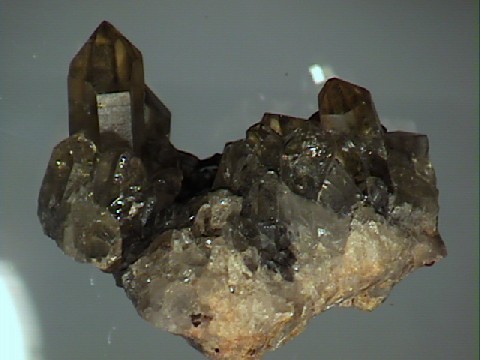
CITRINE specimen cit-18
$ 53.00
$ 53.00
Dims: 1.97x1.49x1.37" (5.01x3.78x3.47cm)
Wt: 1.68oz (47.5g)
Murzinka Mine, Ural Mountains, Russia
This is a natural citrine cluster. The crystals are well-shaped hexagonal and prismatic, although most are small and intergrown. Their color is a pale yellow, and while there are cloudy inclusions, the transparent areas are very clear. The surface of most faces (except the terminations) has a slight pitting which dulls the otherise vitreous luster.
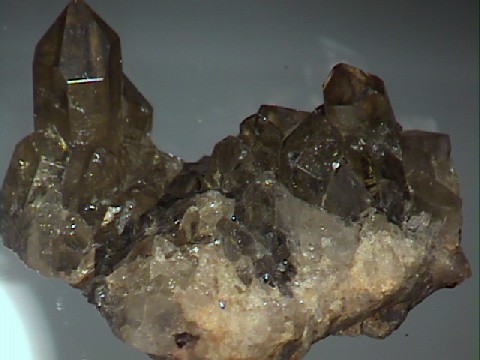

cit-18 ($ 53.00)
Murzinka Mine, Ural Mountains, Russia
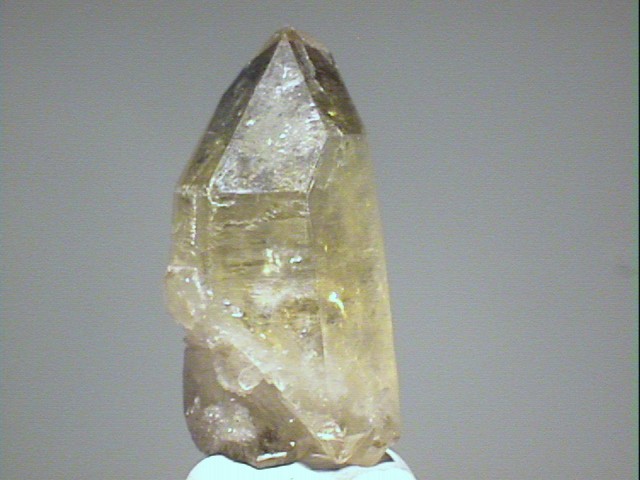
CITRINE specimen cit-19
$ 39.00
$ 39.00
Dims: 1.86x0.98x0.85" (4.72x2.49x2.15cm)
Wt: 0.98oz (27.6g)
Murzinka, Ural Mountains, Russia
This natural citrine crystal is a very pale yellow, transparent specimen. Half of the termination faces are smooth, while the other half (and all of the sides) have varying degrees of pitting which roughens the surface texture, dulling the luster. There are numerous tiny colorless quartz crystals on the base and predominantly on the lower half of one side of the specimen. A loupe reveals that the crystal faces of the citrine are host to hundreds of extremely tiny quartz (or possibly citrine) crystals, plus some other minerals.

cit-19 ($ 39.00)
Murzinka, Ural Mountains, Russia
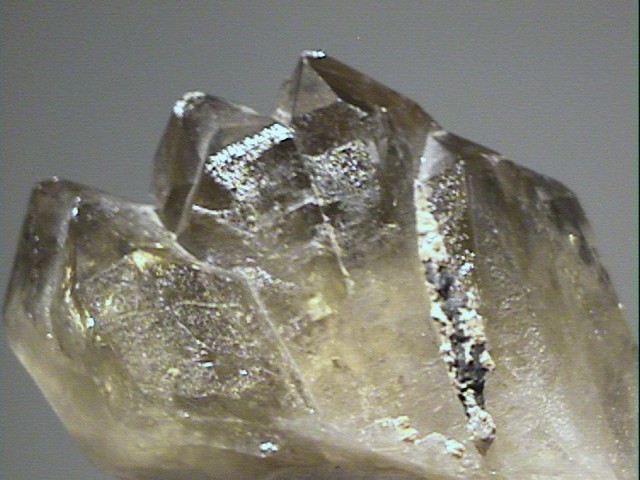
CITRINE specimen cit-20
$ 32.00
$ 32.00
Dims: 1.37x1.27x0.79" (3.48x3.22x2.01cm)
Wt: 0.74oz (20.9g)
Murzinka, Urals, Russia
This is a cluster of a half-dozen natural citrine crystals. They are almost a smoky quartz, as they are a yellow-gray in color. The crystals are transparent with good prismatic form, although they are closely intergrown so that none of the crystals has all six sides exposed (except on their terminations). While they look undamaged (except for the base), close examination reveals damage to all of the points and some of the edges.
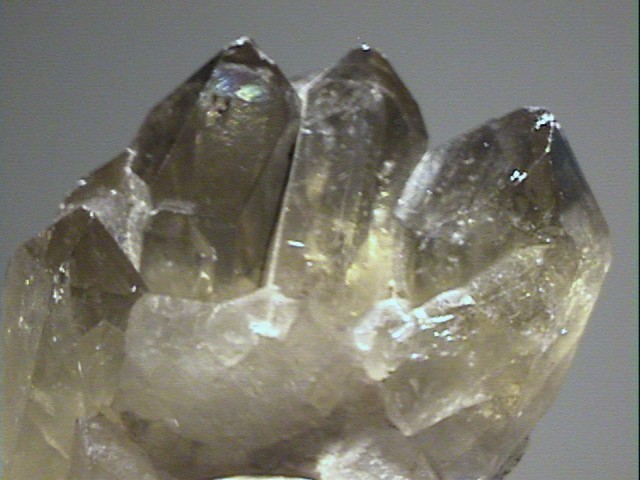

cit-20 ($ 32.00)
Murzinka, Urals, Russia
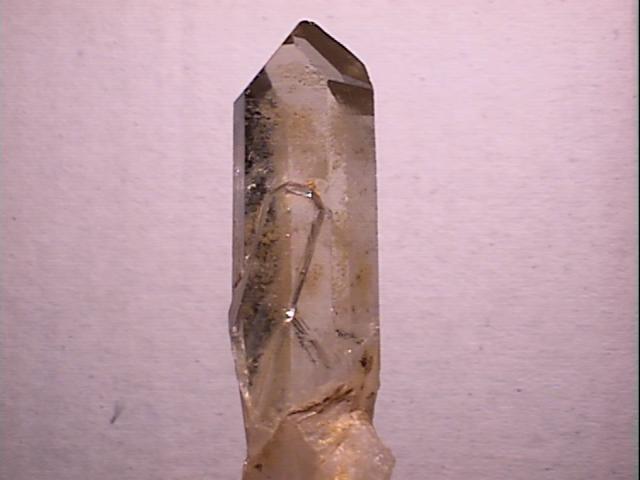
CITRINE specimen cit-21
$ 30.00
$ 30.00
Dims: 2.06x0.67x0.54" (5.24x1.70x1.37cm)
Wt: 0.72oz (20.4g)
Murzinka, Urals, Russia
This is essentially a single large citrine crystal, although there is a base of milky quartz and one smaller citrine crystal interpenetrating two sides of the primary crystal. The citrine is extremely pale, and is transparent with a vitreous luster that has been dulled by numerous tiny pits on the crystal faces. The tip and several edges show damage.
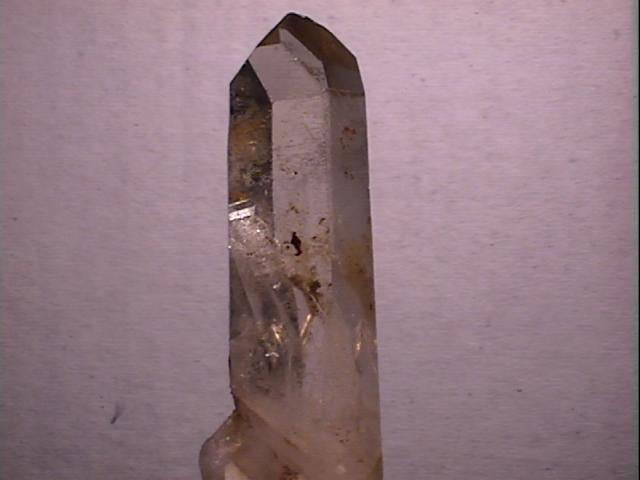

cit-21 ($ 30.00)
Murzinka, Urals, Russia
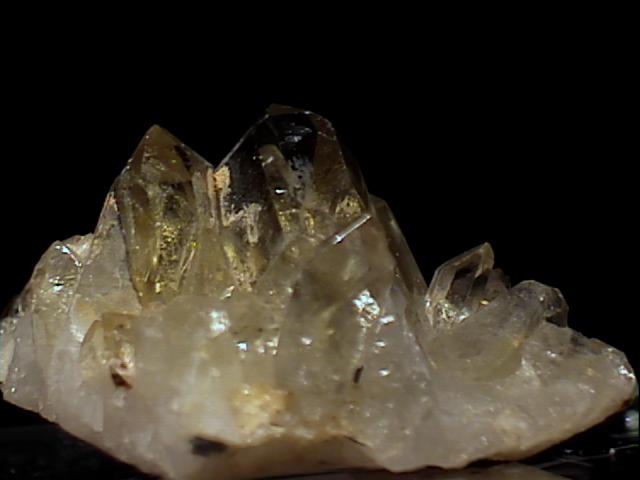
CITRINE specimen cit-22
$ 25.00
$ 25.00
Dims: 1.39x1.13x0.73" (3.52x2.87x1.86cm)
Wt: 0.39oz (10.9g)
Murzinka, Urals, Russia
This is a nice little specimen of natural citrine crystals. The citrine is a pale yellow with a hint of gray, especially in the larger crystals. The citrine is quite transparent with few inclusions, although there are rusty areas on the outside surface. Most of the points and edges have minor damage which is not readily visible without a loupe.
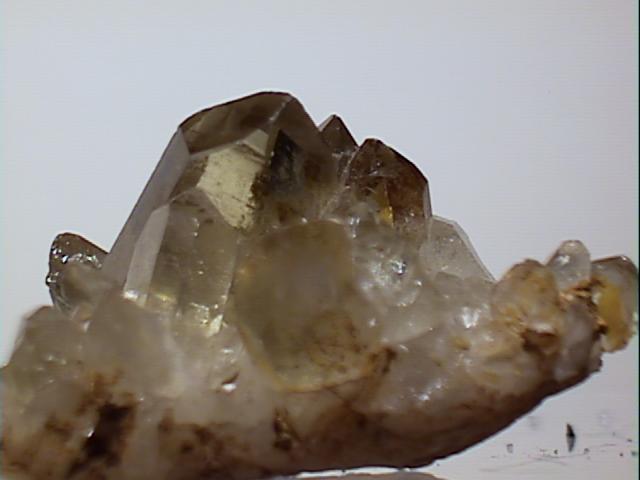

cit-22 ($ 25.00)
Murzinka, Urals, Russia
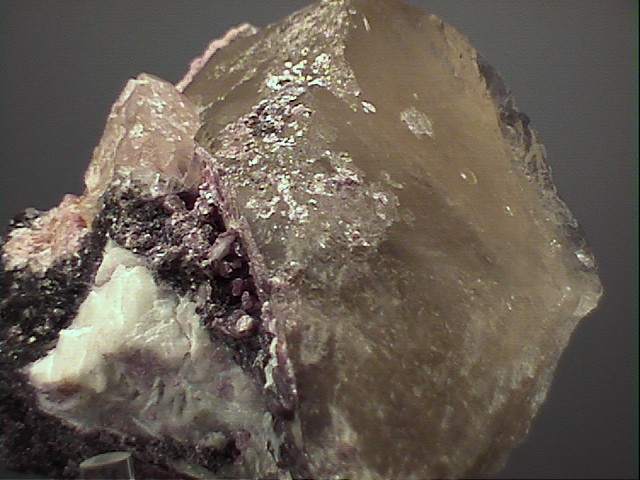
CITRINE specimen cit-23
$ 35.00
$ 35.00
Dims: 3.44x3.41x1.65" (8.73x8.66x4.20cm)
Wt: 9.77oz (277g)
Minas Gerais, Brazil
This specimen is classified as a citrine because of its slightly yellow tint, but I could have calld it a smoky quartz, too, because at first glance the quartz looks gray. While most of the mass of the specimen is this cirtine, most of the surface is covered by an assortment of minerals, including albite, biotite, and very odd formations of a pink mineral that was documented as lepidolite, and while it does look like lepidolite in a few small areas, it mostly looks granular or even botryoidal, with an amethyst color. I do not know what it is, but it does lend color and contrast to the specimen.
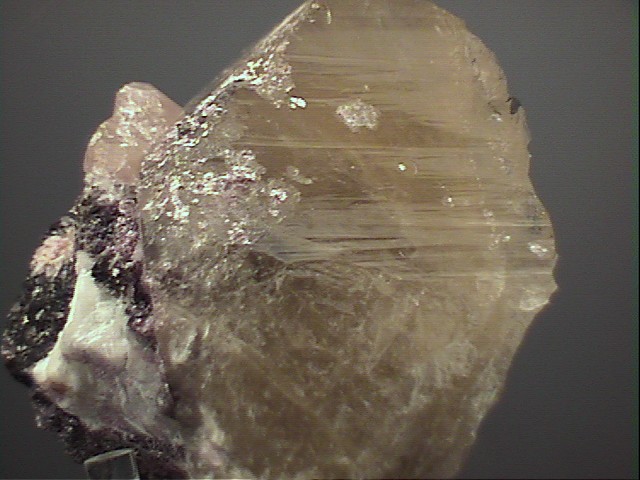

cit-23 ($ 35.00)
Minas Gerais, Brazil